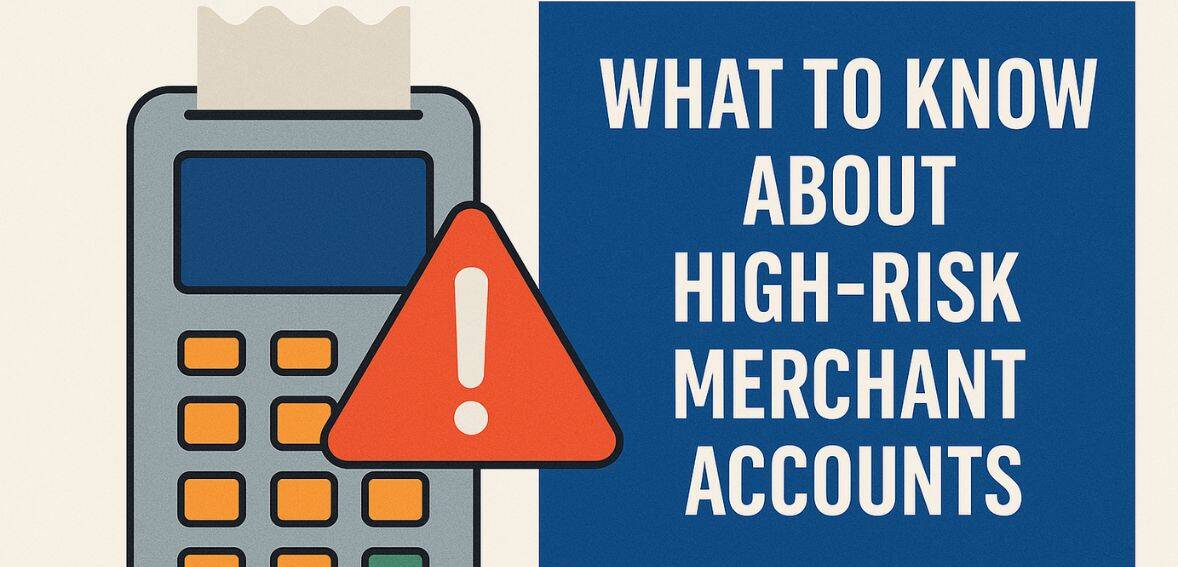
By Jack Black July 24, 2025
If you’re a business owner navigating the payments landscape, you’ve probably come across the term “high-risk merchant account.” It might not sound very safe, but it’s a reality for many industries that operate outside what traditional banks and processors consider low-risk. Whether your business is in adult entertainment, e-commerce, vape sales, CBD, or subscription services, being classified as high-risk doesn’t imply that it is shady; rather, it just indicates that payment providers want to keep a closer eye on it because it involves more variables.
High-risk merchant accounts are often a lifeline for companies with complicated sales models or regulatory baggage. However, they also have unique conditions, higher costs, and increased scrutiny. Knowing the specifics of what constitutes a high-risk merchant account and how to take advantage of it can mean the difference between operating a successful company and being stuck with frozen funds or cancelled contracts.
Why a Business Might Be Considered High-Risk

Banks and processors typically use a set of defined factors to assess a merchant’s risk of disputes, regulatory exposure, or financial loss, which is why the high-risk designation frequently feels frustratingly arbitrary. Selling expensive products, working in chargeback-prone industries, or providing recurring billing models that span months or years are common triggers. Foreign business operations can also raise red flags, such as a credit history that isn’t perfect or a new company with little to no processing history.
In essence, your company is more likely to be classified as high-risk if there is a greater likelihood of fraud, chargebacks, compliance problems, or financial instability. That does not, however, mean that it is unbankable; rather, it indicates that you require a provider who is knowledgeable about your sector and provides resources to lessen those risks.
How Payment Processors Evaluate Risk

Payment processors examine different aspects of your company using risk assessment models. They examine your company’s history with prior processors, average ticket size, refund ratios, and monthly processing volume. Almost always, the outcome will be influenced by the industry you are in, particularly if it has a history of volatile transaction trends or has been flagged by federal banking systems, the FDA, or the FTC.
Providers also look at operational infrastructure. Chargebacks are less likely to occur at a companies with transparent refund policies, safe checkout procedures, and easily accessible customer service. Because of this level of detail in the assessment process, not all high-risk companies are created equal; some just need to demonstrate that they are in charge of their operations through improved documentation and proactive measures.
The Role of Chargebacks
High-risk merchants are more likely to encounter chargebacks, which are one of the main issues in the payment processing industry. When a consumer disputes a transaction and the bank takes the customer’s side, requiring a refund from the merchant’s account, this is known as a chargeback. Severe penalties, account freezes, or even termination may follow high chargeback ratios.
To manage this, high-risk processors often include chargeback management tools or fraud protection systems in their offerings. Customers may experience buyer’s remorse as a result of subscription models, trial offers, or emotionally charged purchases (such as tickets or travel).
High-risk processors frequently incorporate fraud protection systems or chargeback management tools into their products to handle this. These tools assist merchants in keeping acceptable ratios, usually less than 1%, and lowering the risk of disputes.
Pricing Differences Between High-Risk and Traditional Accounts

There is no denying that high-risk merchant accounts are more expensive. Companies should anticipate increased monthly minimums, setup fees, and transaction fees. The main reason for this is that processors are taking on more responsibility, particularly if they must front money before it is completely cleared through a settlement window.
The added fees often include rolling reserves, where a portion of your revenue is held back as a financial safety net. While this might seem punitive, it’s a buffer that protects both you and the processor from potential disputes or customer refunds. It also gives the provider more confidence in extending services to your business long term.
The Importance of Finding a Specialized Provider
Working with a processor that is unfamiliar with your industry can result in costly mistakes if your company is high-risk. After their compliance team gives your application a closer look, you might be onboarded and then dropped a few days or weeks later. Even worse, if your provider lacks the necessary infrastructure to support high-risk industries, you may find your money held indefinitely.
On the other hand, specialized high‑risk merchant account providers have established connections with banks and underwriting teams, so they are aware of what to expect. They are frequently more open about terms and are aware of industry‑specific nuances and compliance requirements. They’re also more equipped to support your success with tools that simplify reconciliation, cut down on chargebacks, and lessen fraud.
Contracts and Long-Term Commitments

Long-term contracts and early termination fees are common features of high-risk merchant accounts. This is just how some providers handle risk, and it’s not necessarily a bad thing. However, you should always read the fine print. Although some processors provide month-to-month agreements and flexible terms, these can occasionally have even higher fees.
Before you sign, find out what will happen if you decide to change industries, your processing volume grows, or your business model changes. Without flexibility, a contract that seems good now could cause issues later. Your evaluation process should include transparency regarding refund policies, cancellation terms, and customer service accessibility.
Underwriting and Application Process
It takes time to apply for a high-risk merchant account. Be prepared to present detailed documentation, such as business licenses, promotional materials, financial records, processing statements, and even identification proof for owners or other interested parties. In order to assess how well you safeguard your clients, some applications might also ask for your refund policy or fulfillment schedule.
Although it may seem intrusive, this procedure is common in the field of high-risk processing. You’ll go through underwriting more quickly if your documentation is ready. A reliable processor will walk you through the process, provide comments on your application materials, and assist you in presenting your company in the most favorable light for approval.
How to Make Your High-Risk Account Work for You
Your work doesn’t end when you get accepted. Consistency and attention to detail are key when managing a high-risk account. Keep an eye on your chargeback rates, address disputes right away, and use fraud detection tools to highlight suspicious activity. Make sure your customer service team is aware of how to quickly and effectively handle complaints or refund requests, and train your employees on best practices.
You should have a continuous relationship with your processor. Seek out partners who keep lines of communication open, offer updated fraud tools, and conduct routine account reviews. Your processor should develop alongside your company as it expands and changes, not interfere with outdated processes or excessive bureaucracy.
When to Re-Evaluate Your Provider
Not all processors are made equal, even in the high-risk industry. It’s possible that your provider won’t grow with you or that their service offerings won’t change to accommodate new technologies or compliance requirements. It might be time to reevaluate your options if you’re dealing with inexplicable fund holds, subpar customer support, or antiquated tools.
Eventually, a lot of high-risk companies build robust documentation systems, decrease chargebacks, and improve their processing history. You might then be eligible for better conditions or reduced costs. Never be scared to switch providers or renegotiate if it better fits your current level of business maturity.
Global vs. Domestic Considerations
The decision between a domestic or offshore high-risk merchant account can be crucial for companies that sell internationally. While offshore accounts can provide greater flexibility with fewer limitations, they also present new difficulties, such as currency exchange, regulatory disparities, and occasionally weakened legal protections.
Conversely, domestic providers are more likely to adhere to U.S. banking regulations and provide faster dispute resolution times. Your company’s structure, multi-channel payments, and clientele’s geographic location all influence the best option. You can find the best course of action and guarantee compliance in every region with the assistance of a processor with international experience.
Conclusion
For many forward-looking, rapidly expanding companies, high-risk merchant accounts are a reality rather than a punishment. For businesses that just don’t fit the traditional mold, they act as entry points to safe, dependable payment processing. A high-risk account is the best option for accepting payments, preventing fraud, and maintaining compliance, regardless of whether you’re working in a regulated industry, handling large ticket sizes, or handling recurring payments.
Finding a processor who understands your industry, meets your needs, and guides you through obstacles in a clearly and cooperatively is crucial. Even the most complicated high-risk environment can be controlled with the correct provider and a deliberate strategy. You’ll be in a good position to scale, grow, and confidently serve your customers if you approach your merchant account as a business asset rather than a barrier.
Leave a Reply